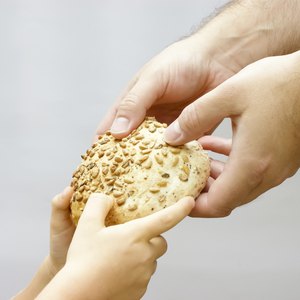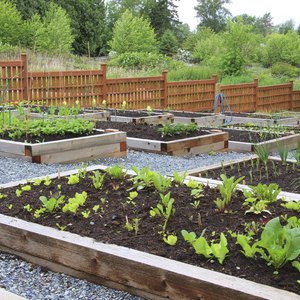
Many areas have at least a small population of hungry or homeless folks, as well as charities who serve the underprivileged. If you're feeling inspired to help the those in need without having to spend your own food budget to do so, ask local businesses and organizations to help contribute to your efforts. You just may inspire others to do attempt to reduce the amount of hunger in your area.
Organize a Food Drive

A food drive turns food donation into a community effort. Ask local businesses and organizations if you may place collection boxes within their buildings so others can chip in. Tape a sign to each box indicating why the food is being collected and whom it will benefit -- typically, a local shelter or organization that serves free meals. Be sure to post that only non-perishable goods can be accepted, such as boxed or canned items that can be kept in a pantry. Post notices about your collection effort on your community's online forums or on public bulletin boards in places such as independent coffee shops. Visit the box locations on a weekly basis, emptying or replacing the boxes as needed. Tell a local food pantry or soup kitchen in advance that you plan to donate a quantity of items so you can arrange a drop-off time.
Bread Bonanza

Talk to the managers at local bakeries and grocery-store bakery departments, asking what they do with their unsold breads and fresh-baked goods at the end of each day. Tell them you'd like to take the items to local shelters, food pantries and soup kitchens, or that you would like to use the breads to make sandwiches for the homeless on a regular basis. If the bakers do not already donate their unsold goods, they may be happy to offer the goods to you. Make sure you or a helper can pick up the items each night or at designated times to establish an ongoing relationship with the company offering the bread. Since fresh-baked breads, rolls and pastries do not contain the preservatives found in some foods, they must be used within a day or two, so be sure you are able to both pick up and offer the foods within a short time to ensure food safety.
Produce Power

Many organizations that feed the homeless and underprivileged greatly appreciate fresh produce since a majority of the donations such places receive consists of non-perishable or pre-packaged items instead of fresh food. Ask to meet with the produce manager at local groceries, or visit farmer's markets to tell vendors of your desire to feed the less fortunate. Some of them may offer you bruised or past-prime produce that needs to be used right away. Only collect such produce if you are able to get it to an organization or to people who can use it within a day; otherwise, the food may not be usable.
Get Growing

If space allows, or if you have a patio and can garden in containers, grow food with the intent to share it with the hungry. Ask other gardeners in your neighborhood -- especially at community garden sites -- to help your efforts. As any gardener knows, plants often produce a bounty far beyond what the gardener can use before the fresh produce spoils. Set up bins or boxes at participating garden sites and ask gardeners to inform you each day when they have fresh-picked produce to share. Some eager gardeners may even volunteer to drop off the food for you from time to time at a local shelter or free-meal site.
Create or Join a Movement

Start your own free-food movement by telling others in your community about it, or by joining an effort already in place such as HashtagLunchbag. Group effort is key to the success of such efforts; specific dates and times are set up to put together sandwiches and meals for the homeless, and the volunteers helping out are asked to bring specific food items or cash to help purchase supplies for the effort.
References
Resources
Writer Bio
Kathy Adams is an award-winning journalist and freelance writer who traveled the world handling numerous duties for music artists. She writes travel and budgeting tips and destination guides for USA Today, Travelocity and ForRent, among others. She enjoys exploring foreign locales and hiking off the beaten path stateside, snapping pics of wildlife and nature instead of selfies.

